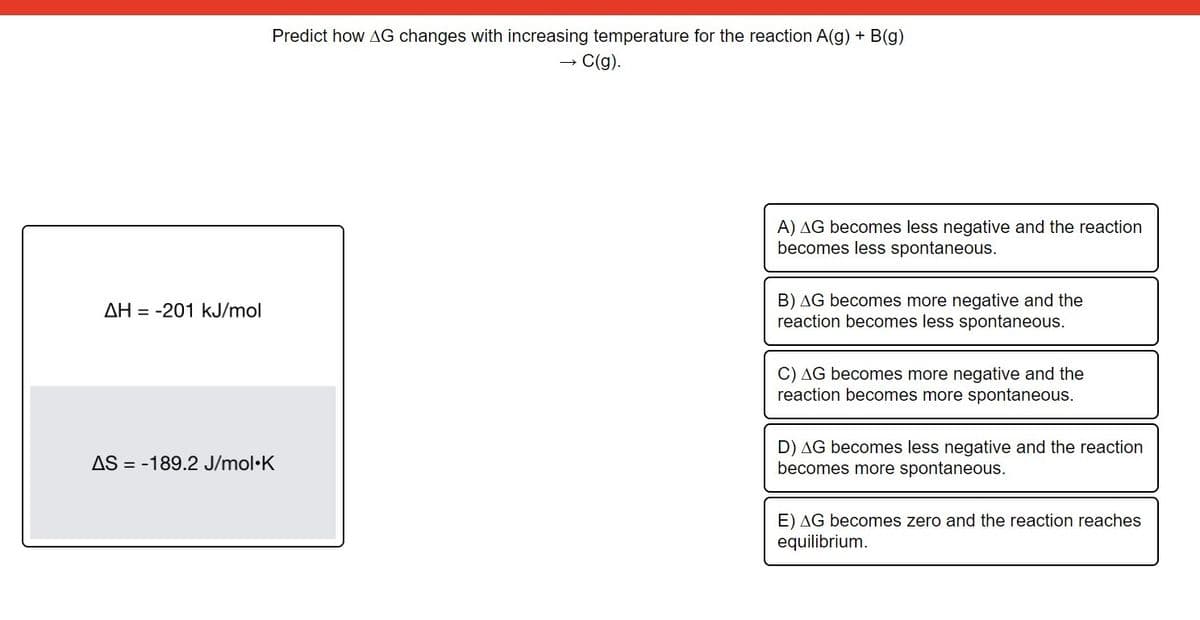Predict how AG changes with increasing temperature for the reaction A(g) + B(g) - C(g). A) AG becomes less negative and the reaction becomes less spontaneous. B) AG becomes more negative and the reaction becomes less spontaneous. AH = -201 kJ/mol C) AG becomes more negative and the reaction becomes more spontaneous. AS = -189.2 J/mol·K D) AG becomes less negative and the reaction becomes more spontaneous. E) AG becomes zero and the reaction reaches equilibrium.
Predict how AG changes with increasing temperature for the reaction A(g) + B(g) - C(g). A) AG becomes less negative and the reaction becomes less spontaneous. B) AG becomes more negative and the reaction becomes less spontaneous. AH = -201 kJ/mol C) AG becomes more negative and the reaction becomes more spontaneous. AS = -189.2 J/mol·K D) AG becomes less negative and the reaction becomes more spontaneous. E) AG becomes zero and the reaction reaches equilibrium.
Chemistry: Principles and Practice
3rd Edition
ISBN:9780534420123
Author:Daniel L. Reger, Scott R. Goode, David W. Ball, Edward Mercer
Publisher:Daniel L. Reger, Scott R. Goode, David W. Ball, Edward Mercer
Chapter17: Chemcial Thermodynamics
Section: Chapter Questions
Problem 17.109QE: Chemists and engineers who design nuclear power plants have to worry about high-temperature...
Related questions
Question
100%

Transcribed Image Text:Predict how AG changes with increasing temperature for the reaction A(g) + B(g)
→ C(g).
A) AG becomes less negative and the reaction
becomes less spontaneous.
B) AG becomes more negative and the
reaction becomes less spontaneous.
AH = -201 kJ/mol
C) AG becomes more negative and the
reaction becomes more spontaneous.
AS = -189.2 J/mol•K
D) AG becomes less negative and the reaction
becomes more spontaneous.
E) AG becomes zero and the reaction reaches
equilibrium.
Expert Solution
This question has been solved!
Explore an expertly crafted, step-by-step solution for a thorough understanding of key concepts.
This is a popular solution!
Trending now
This is a popular solution!
Step by step
Solved in 2 steps with 1 images

Knowledge Booster
Learn more about
Need a deep-dive on the concept behind this application? Look no further. Learn more about this topic, chemistry and related others by exploring similar questions and additional content below.Recommended textbooks for you

Chemistry: Principles and Practice
Chemistry
ISBN:
9780534420123
Author:
Daniel L. Reger, Scott R. Goode, David W. Ball, Edward Mercer
Publisher:
Cengage Learning

Chemistry for Engineering Students
Chemistry
ISBN:
9781337398909
Author:
Lawrence S. Brown, Tom Holme
Publisher:
Cengage Learning

General Chemistry - Standalone book (MindTap Cour…
Chemistry
ISBN:
9781305580343
Author:
Steven D. Gammon, Ebbing, Darrell Ebbing, Steven D., Darrell; Gammon, Darrell Ebbing; Steven D. Gammon, Darrell D.; Gammon, Ebbing; Steven D. Gammon; Darrell
Publisher:
Cengage Learning

Chemistry: Principles and Practice
Chemistry
ISBN:
9780534420123
Author:
Daniel L. Reger, Scott R. Goode, David W. Ball, Edward Mercer
Publisher:
Cengage Learning

Chemistry for Engineering Students
Chemistry
ISBN:
9781337398909
Author:
Lawrence S. Brown, Tom Holme
Publisher:
Cengage Learning

General Chemistry - Standalone book (MindTap Cour…
Chemistry
ISBN:
9781305580343
Author:
Steven D. Gammon, Ebbing, Darrell Ebbing, Steven D., Darrell; Gammon, Darrell Ebbing; Steven D. Gammon, Darrell D.; Gammon, Ebbing; Steven D. Gammon; Darrell
Publisher:
Cengage Learning

Chemistry: An Atoms First Approach
Chemistry
ISBN:
9781305079243
Author:
Steven S. Zumdahl, Susan A. Zumdahl
Publisher:
Cengage Learning

Chemistry
Chemistry
ISBN:
9781305957404
Author:
Steven S. Zumdahl, Susan A. Zumdahl, Donald J. DeCoste
Publisher:
Cengage Learning
